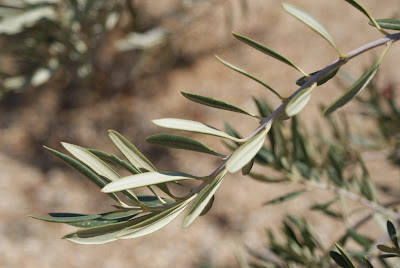In my front yard I have three olive trees. They are the fruitless, pollenless Swan Hill variety. Many communities and homeowner's associations, including ours, prohibit the planting of olive trees because of the pollen and the fruit they drop which causes staining. I have never seen or grown olive trees before, so I do not know how much of a problem that can be. The Swan Hill variety is the only variety of olive tree allowed in our neighborhood. I found out that they have been around for about thirty years, and were patented by the University of California, Davis, CA.
 |
| Swan Hill olive tree |
 |
| olive tree leaves |
There are five pygmy date palms (Phoenix roebelenii) growing in our yard, three in the back yard and two along the front of the house. I discovered that these are a species of date palm native to Southeast Asia. In the wild, these are usually single-trunked, but here most nurseries plant them as multiples together. Ours all have three trunks.
 |
| Pygmy date palm |
Our trees have a dense, graceful crown and dark green leaves that arch to the ground. I think they give a tropical feel to our dry, desert yard. They produce small, yellowish flowers that are mostly hidden by the arching leaves, and a small (1 cm) fruit that looks like a thin-fleshed date. I have been stabbed a time or two by the sharp spines that are present on the leaf where it attaches to the trunk. I only prune the leaves that die off, and have only fertilized once when planting, but they look like they need it again. There is some browning of the leaf tips that may signal micronutrient deficiencies. Browning can also occur because of frost damage, and our trees suffered a small amount of damage this winter when we had the freezes.
 |
| Pygmy date palm flowers |
As I conclude this post, here is an interesting tidbit of information about palms and olives. In Milwaukee, Wisconsin, B.J. Johnson produced a soap in 1898 made entirely of palm and olive oils. He called it Palmolive and named his company after it. At the turn of the century, it was the world's best selling soap. This company is now known as the Colgate-Palmolive Company.
Seems you've struck gold in those two trees. Horticulturally, I mean, as they look like they belong there. Speaking of striking gold, ol' B.J. certainly did. Fascinating historical note.
ReplyDeleteThanks, Lee. We do enjoy the trees, particularly the palms. I thought it was fascinating about B.J. also.
ReplyDelete